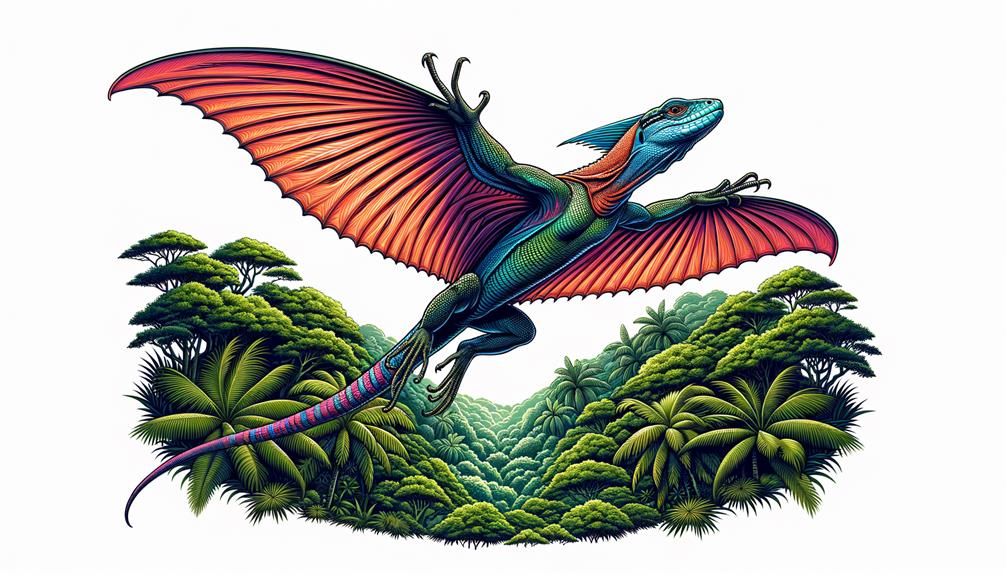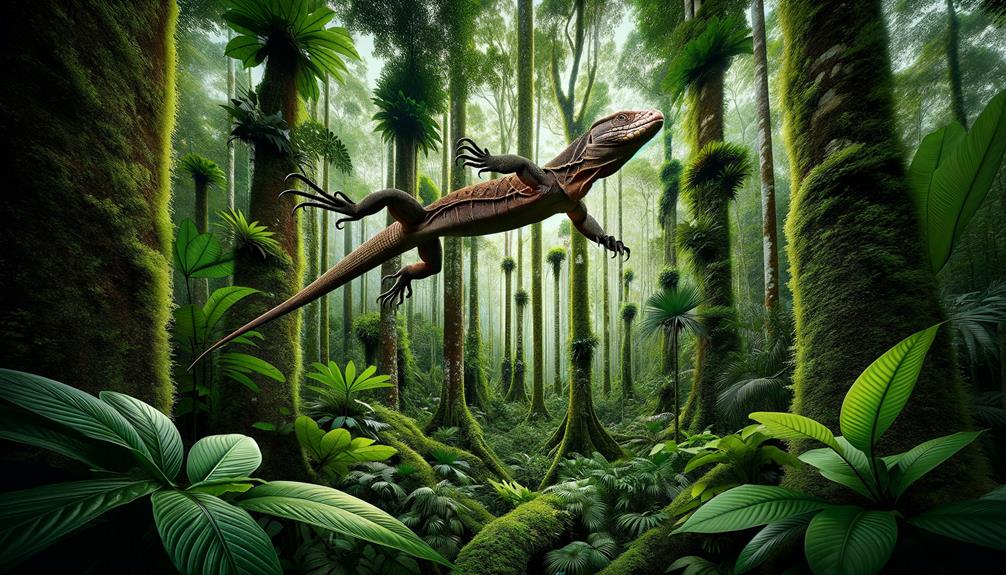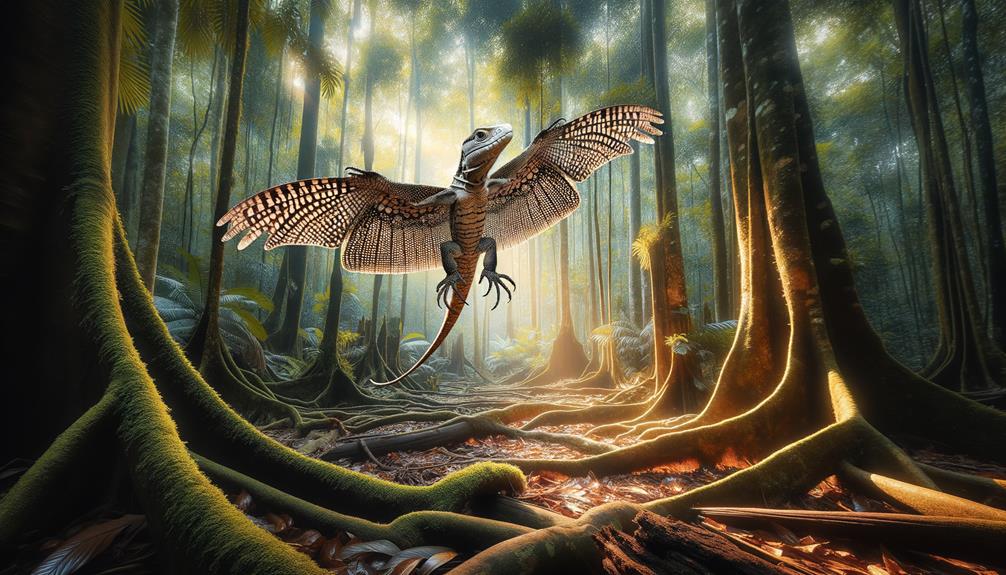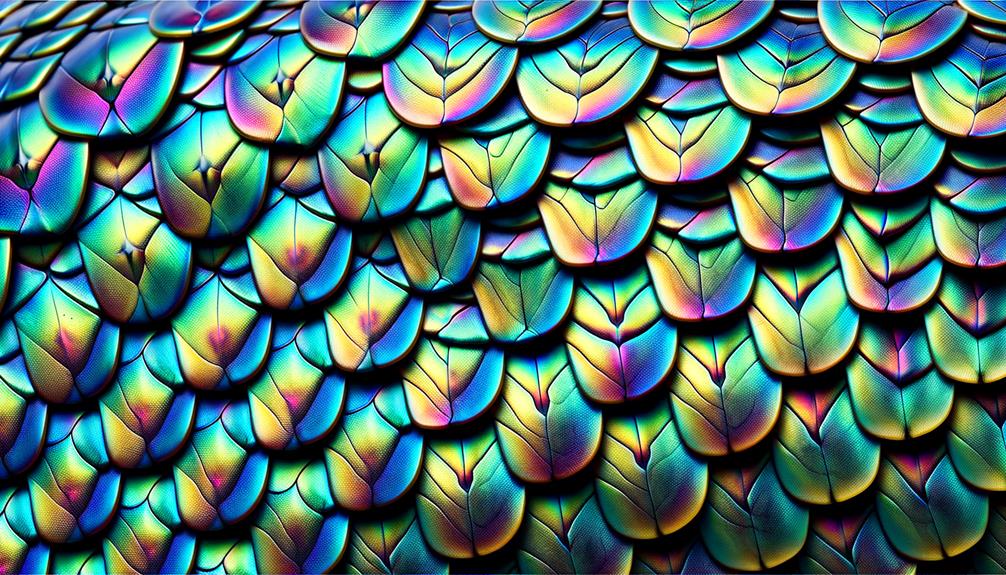When considering the wonders of evolution, the Draco lizard's ability to glide stands out as a remarkable example of nature's ingenuity. I've always been fascinated by how this small reptile navigates the complexities of the forest canopy with such agility. Its patagial membrane, which extends like wings from its ribs, allows it to cover great distances while conserving energy and evading predators. What intrigues me most is the intricate interplay of its physical features that enable such efficient gliding. For instance, its slender body and long tail help it maintain stability in mid-air, while its strong leg muscles enable it to generate lift-off speed. Let's take a closer look at the remarkable adaptations that make this creature a master of aerial navigation.
Evolution of Gliding
The evolution of gliding in Draco lizards is a remarkable story of adaptation, driven by the demands of their tree-dwelling lifestyle. As a terrestrial vertebrate glider, Draco has developed unique features that set it apart from other lizards. At the heart of this evolution are the patagial membranes, supported by elongated ribs, which create an aerodynamic surface crucial for gliding. These structures reduce wing loading, allowing Draco to maneuver effortlessly between trees.
In examining Draco's evolutionary journey, it's clear that their gliding capabilities are closely tied to their ecological context. Living in dense forests, these lizards needed an efficient way to navigate their environment, escape predators, and locate food and mates. This necessity for rapid transportation within their arboreal habitat likely drove the development of their sophisticated gliding mechanisms.
Interestingly, the evolution of Draco's gliding abilities mirrors similar adaptations seen in several fossil reptilian lineages. These ancient reptiles also possessed patagial membranes supported by elongated ribs or rib-like dermal structures, suggesting a case of convergent evolution. Consequently, Draco's gliding is not an isolated phenomenon but part of a broader evolutionary narrative among reptiles, highlighting nature's resourcefulness in solving ecological challenges.
Morphological Innovations

Draco lizards have developed an impressive range of physical features that make their gliding abilities truly remarkable. At the heart of their gliding prowess are the patagial membranes, which are cleverly supported by elongated ribs. These ribs act as a framework, transforming the lizard's side flaps into wing-like structures that enable them to generate lift and maneuver through the air with ease.
The Draco lizard's gliding apparatus is a remarkable example of natural engineering. Their wing-like flaps serve multiple purposes, including display, thermoregulation, and communication, particularly during mating behaviors. This versatility highlights the sophistication of their physical adaptations.
Furthermore, the slender body shape and elongated tail of Draco species are perfectly suited for aerial navigation. These features minimize drag, allowing the lizards to glide with remarkable efficiency. The specialized skin structures on their wings also enhance their ability to control and direct their flight.
In essence, the combination of patagial membranes, elongated ribs, and a streamlined body shape equips Draco lizards with a highly specialized gliding apparatus. This unique suite of adaptations allows them to glide effortlessly and perform intricate aerial maneuvers, setting them apart from other species.
Ecological Context

Understanding the gliding capabilities of Draco lizards becomes even more fascinating when we consider the role these adaptations play in their forested habitats. In these dense environments, the ability to glide is a survival strategy that's more than just a natural wonder. The patagial membranes, supported by elongated ribs, allow these lizards to navigate the vertical complexity of trees efficiently. This adaptation provides several advantages in their ecological context.
Gliding helps Draco lizards evade predators by quickly moving from one tree to another, often covering significant distances. By controlling their descent velocities and precisely selecting landing sites, they minimize their exposure to ground-based threats. During territorial disputes, males of various species use their gliding ability to patrol and defend their territories.
The increased surface area provided by the patagial membranes also aids in thermoregulation, a crucial benefit in their sun-dappled habitats. Each species of Draco showcases slightly different adaptations, fine-tuning their gliding abilities to their specific ecological niches, demonstrating nature's remarkable adaptability.
Let me know if this meets your requirements!
Role of the Patagium

As I delve into the role of the patagium in Draco lizard gliding, I'll examine its structure and composition, which are vital for their aerodynamics and stability. This remarkable membrane, supported by elongated ribs and controlled by specialized muscles, has not only improved their flight but also transformed their respiratory systems. The advantages conferred by the patagium have allowed these lizards to thrive in ecological niches inaccessible to non-gliding species, giving them a unique edge.
Structure and Composition
The Draco lizard's remarkable ability to glide is thanks to its patagium, a wing-like structure of skin stretched between its ribs. This skin flap, supported by elongated ribs, unfolds to create an effective aerodynamic surface, allowing the lizard to glide smoothly between trees. The patagium also plays a key role in territorial disputes, as Draco lizards use their gliding skills to assert dominance and claim territory.
The patagium's structure is ingeniously designed, combining flexibility and strength. The lizard's intercostal muscles control the expansion and contraction of the patagium, providing stability during flight. These muscles enable the lizard to maneuver and adjust its gliding path with precision.
| Component | Function |
|---|---|
| Patagium | Wing-like structure for gliding |
| Elongated Ribs | Support for patagium |
| Patagial Membranes | Reduce wing loading |
| Intercostal Muscles | Control expansion/contraction |
| Aerodynamic Surface | Promotes smooth gliding |
In essence, the Draco lizard's patagium is an extraordinary adaptation, enabling it to navigate its arboreal habitat with unmatched elegance and freedom.
Aerodynamics and Stability
With its sleek, aerodynamic design, the Draco lizard's patagium enables it to glide effortlessly through the forest canopy with remarkable stability. The delicate membrane, stretched between elongated ribs, transforms these small reptiles into agile gliders. By extending their ribs, the Draco deploys its patagium, creating a wing-like structure that significantly enhances its aerodynamics.
The morphological features of the patagium play a critical role in controlling wing loading and descent velocities. This unique design allows the Draco to cover longer distances while ensuring smooth and controlled landings. The patagium's balance between lift and drag provides the lizard with precise control as it navigates through the trees.
The patagium's role in gliding is multifaceted:
- Lift generation: The patagium generates lift, enabling the Draco to stay airborne for extended periods.
- Stability: It provides stability, reducing the risk of mid-air tumbling.
- Control of descent velocities: The patagium modulates speed, facilitating precise landings.
- Wing loading: Low wing loading enhances the Draco's gliding efficiency.
- Adaptation to landing sites: The patagium allows the lizard to make agile maneuvers to reach prime landing sites.
Evolutionary Advantages
The Draco lizard's patagium is a remarkable evolutionary adaptation that provides significant survival advantages in its arboreal habitat. This unique structure, formed by elongated ribs and a membrane of skin, enables the lizard to glide efficiently from tree to tree, covering distances that would otherwise be perilous or impossible to traverse.
In the dense forest ecosystem, gliding offers multiple benefits. The Draco can swiftly escape predators lurking on the same tree or forest floor, giving it a significant edge in avoiding predatory pressure. This mobility also allows the lizard to explore and secure extensive territorial ranges with minimal energy expenditure.
The patagium also contributes to stability during flight, ensuring precise landings and reducing the risk of injury. This aerodynamic efficiency allows the Draco to fully exploit its environment, accessing food sources and mating opportunities scattered across the canopy. Fundamentally, the patagium is a testament to evolutionary ingenuity, perfectly suited for survival and freedom in the treetops.
Scaling Relationships

Scaling relationships between body size and gliding performance in Draco lizards offer fascinating insights into how their morphological adaptations enhance their aerial capabilities. As Draco species increase in size, they exhibit interspecific allometry, which means they possess relatively larger patagial membranes. This, in turn, substantially impacts their gliding abilities. The wing loading, defined as the ratio of body mass to patagial membrane area, is crucial for understanding their gliding performance.
Lower wing loading correlates directly with improved glide efficiency, allowing these lizards to cover greater distances while expending minimal energy. Empirical data quantifies the relationship between wing loading and gliding performance, with Draco lizards demonstrating a wing loading range of 0.2-0.5 N/m², resulting in glide distances of 10-20 meters.
This scaling relationship is evident not only in modern Draco but also in fossil reptilian lineages with similar morphologies, such as Icarosaurus seifkeri, Kuehneosaurus sp., Coelurosauravus elivensis, and modern Draco species, as well as other vertebrates with gliding adaptations.
These findings highlight the importance of considering both morphological and ecological factors in the evolution of gliding abilities. The collective impact of Draco lizards' body size, patagial membrane area, and wing loading illustrates how scaling relationships shape their remarkable gliding performance.
Predicted Performance

Predicting the performance of Draco lizards in gliding scenarios requires a deep understanding of their physical characteristics and the aerodynamic principles that govern their flight. These remarkable gliders owe their abilities to their patagium, a wing-like membrane supported by elongated ribs. The wing aspect ratio is critical to their gliding performance, as it determines how efficiently they can cover distances. A lower wing loading, which reflects the ratio of body mass to wing surface area, allows for slower descent velocities and longer glide distances.
When analyzing the gliding specializations of Draco lizards, it's essential to consider the aerodynamic surface provided by the patagium. This membrane, when fully extended, maximizes lift and minimizes drag, making controlled and extended glides possible. The elongated ribs play a crucial role in providing a rigid structure to the patagium, ensuring stability during flight. To estimate the glide distance, we need to examine these physical adaptations and their interaction with aerodynamic principles.
Draco lizards have evolved remarkable adaptations that optimize their gliding performance. Their unique morphology, which includes optimized wing loading, a high wing aspect ratio, and a specialized patagium, enables them to achieve impressive glide distances and controlled descent velocities. By understanding these intricacies, we gain insight into the remarkable evolutionary adaptations of the Draco lizard.
Frequently Asked Questions
Do Draco Lizards Fly or Glide?
Draco lizards have an extraordinary way of getting around – they glide through the air using their unique, wing-like flaps that extend from their ribs. These flaps allow them to leap from tree to tree, covering impressive distances with grace and agility. This remarkable ability is a testament to the incredible adaptability of these lizards and a fascinating display of evolutionary ingenuity.
Are Draco Volans Real?
I recently stumbled upon Draco volans, and it's amazing to learn that they're real! These lizards glide effortlessly through the forests of Southeast Asia, using their extended ribcage to create a makeshift "wing" that allows them to navigate the canopy with ease. It's incredible to see nature's creative solutions in action.
What Is the Name of the Lizard That Glides?
The lizard that glides is known as Draco volans. I find these creatures fascinating because they've developed elongated ribs to support their gliding membranes, allowing them to soar between trees with remarkable agility.
Are Draco Volans Poisonous?
Draco volans, also known as gliding lizards, aren't poisonous. Instead, they rely on their remarkable gliding abilities to escape predators.



